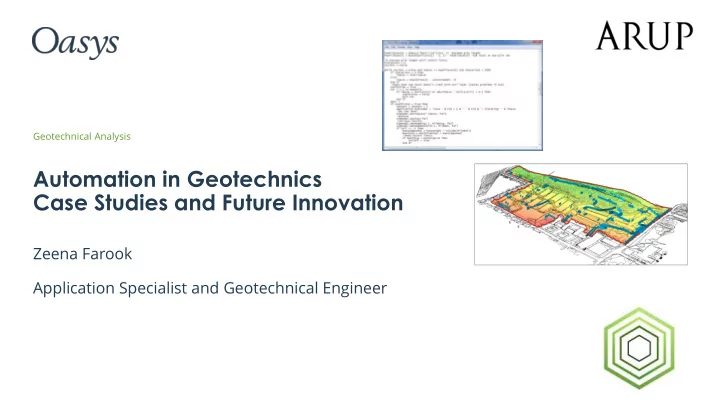

Geotechnical Analysis Automation in Geotechnics Case Studies and Future Innovation Zeena Farook Application Specialist and Geotechnical Engineer
Discuss 1. Drive for Automation in Geotechnics 2. Case Study Examples 3. Opportunities and challenges from Automation 4. How to find out more
Authors • Mark Skinner – Senior Geotechnical Engineer, Arup • Matthew Brown – Senior Geotechnical Engineer, Arup • Carol Matthews – Associate, Arup and Lead Geotechnical Developer, Oasys • Zeena Farook Exhibiting at Booth 15
Oasys Customers Exhibiting at Booth 15
Universities using Oasys Exhibiting at Booth 15
Why Automate? Figures for concept illustration from Zhang et al (2016), The Workflow and Operational Model for Geotechnical Investigation based on BIM, IEEE Open Access Journal Exhibiting at Booth 15
How do we Automate? • Allow external programs to pass information and instructions to and from each other • Use COM (Component Object Model). Can use Excel (VBA), MATLAB and Python Exhibiting at Booth 15
Where can we Automate? • Input • Import of data from various other sources • Geometry from GIS or CAD • SI data from AGS format ? What about interpretation? • Instrumentation data • Analysis • Sensitivity analyses / iteration / optimisation • Back-analysis • Output • Export for post-processing • Databases Exhibiting at Booth 15
Case Study 1 – Retaining Wall Automation • Large site on a ~1:6 slope. • Lots of terracing of the ground profile required • Retained height, retained slope and geology varied • Wanted an ‘ off the shelf ’ L section retaining wall solution to each situation, as the site layout was still being developed. Exhibiting at Booth 15
Case Study – Retaining Wall Automation Exhibiting at Booth 15
Why did we automate? • Design lots of walls very quickly, with just a table of input parameters. • Changing geometry • Changing soil parameters • Easy to optimise designs • Iterate heel length to optimise FoS • Calculate max retained height for a given geometry • Sensitivity investigations – quickly plot outputs • Incremental analyses • Get max bending moment from compaction pressures during incremental backfilling Exhibiting at Booth 15
Case Study 2 – Single Bored Pile Design Inputs Automated calculations Outputs Loads Pile length Calculation spreadsheet runs iterative design calculations: 1) Lateral calculations Ground model Critical case Four alp models per load case. ULS ULS SLS SLS Length iterated to iteration 1 2 1 2 limits. Base models Iterated models 2) Axial calculations and log file Axial (compression and tension) capacity calculations completed, for ULS1, ULS2 and SLS. Pile length iterated until FoS = 1 in each case. EI Pile properties Extracted BM and displacement 3) Determination of design length … is the longest of any case (lateral or axial). Displacement limit Displacement interpretation Exhibiting at Booth 15
Opportunities from Automation • Time saving Overall time reduction dependant of size of analysis. The bigger the analysis the bigger the saving • Input data (40%) • Output generation / plotting maps (40%) • Help us to avoid and prevent human errors • Iterative / multiple analysis (RW movements, etc) • Future plans for real-time monitoring. Back analysis and Observational Method Exhibiting at Booth 15
Challenges from Automation • Only small numbers of calculations or load cases required? Use on larger projects • Less checking and reviewing could potentially and incorrectly be justified Check base model and outputs carefully. Models need to be created • Difficult to check the code rather than calculations that have been presented step-by-step Developers within design teams? Exhibiting at Booth 15
Future Trends • Engineers or developers? • Modular automation • Interdisciplinary automation • Design on demand Exhibiting at Booth 15
Discuss 1. Drive for Automation in Geotechnics 2. Case Study Examples 3. Opportunities and challenges from Automation 4. How to find out more
Automation in Geotechnics Case Studies and Future Innovation Visit us at Booth 15 (near the lifts) Any Questions?
Recommend
More recommend